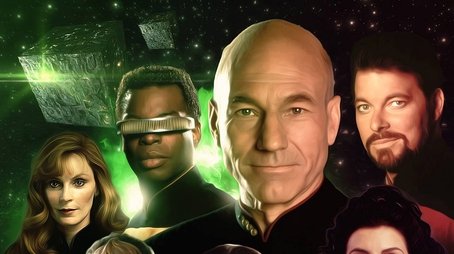
Ask Your Own Question
What is the plot?
In the episode "Encounter at Farpoint," the crew of the USS Enterprise-D, under the command of Captain Jean-Luc Picard, is introduced as they embark on their maiden voyage. The ship is a state-of-the-art starship, and the crew is a diverse group, including Commander William Riker, Lieutenant Commander Data, and Counselor Deanna Troi. As they prepare to leave space dock, there is a sense of excitement and anticipation among the crew. Picard is stern yet charismatic, establishing his leadership style.
The Enterprise receives a distress signal from Farpoint Station, a newly constructed facility on the planet Deneb IV. The crew is tasked with investigating the station and determining its operational status. As they approach the station, they encounter a mysterious and powerful being known as Q, who appears in a flash of light. Q challenges Picard and the crew, claiming that humanity is a dangerous species and must be judged. He puts them on trial for the crimes of humanity, setting the stage for the conflict that will unfold.
Upon arriving at Farpoint Station, the crew discovers that the station is not functioning properly. They find that the station's construction is shrouded in mystery, and there are strange occurrences, including the appearance of a giant jellyfish-like creature. Riker and Data beam down to the planet to investigate further. They meet the inhabitants of the planet, who are wary of the crew and reveal that they have been experiencing strange phenomena related to the station.
As the investigation continues, Riker and Data discover that the jellyfish creature is actually a sentient being that has been captured and is being used to power the station. They learn that the creature is being tortured and that the station's construction involved exploiting its abilities. Riker is deeply affected by this revelation, feeling a strong sense of empathy for the creature and a moral obligation to help it.
Meanwhile, Q continues to taunt Picard and the crew, challenging their decisions and questioning their morality. He creates various scenarios to test them, including a confrontation with a hostile alien species. The crew must work together to navigate these challenges, showcasing their skills and teamwork. Picard remains resolute, determined to prove humanity's worth and to protect the innocent.
As the climax approaches, Riker and Data devise a plan to free the jellyfish creature and confront the true nature of Farpoint Station. They communicate with the creature, who reveals its pain and suffering. Riker, driven by compassion, decides to help it escape. The crew works together to disable the station's systems, allowing the creature to break free from its confinement.
In a dramatic confrontation, Q appears again, demanding that Picard and the crew face the consequences of their actions. However, Picard stands firm, arguing that they have shown compassion and the ability to change. The jellyfish creature, now free, reveals its true form and demonstrates its power, showcasing its ability to manipulate energy and matter. It confronts Q, who is taken aback by the creature's strength.
Ultimately, Q is forced to acknowledge the crew's actions and their capacity for good. He dismisses the trial, stating that humanity has the potential for greatness. The episode concludes with the crew of the Enterprise-D solidifying their bond and commitment to exploring the galaxy, setting the stage for their future adventures. The ship departs Farpoint Station, leaving behind the mysteries of the planet and the challenges they have faced, ready to embrace the unknown.
What is the ending?
The ending of Star Trek: The Next Generation occurs in the series finale titled "All Good Things..." where Captain Jean-Luc Picard finds himself shifting through time, experiencing events from both the past and the future. Ultimately, he learns that he must resolve a temporal anomaly threatening humanity's existence. With the help of his crew, he successfully prevents the catastrophe, and the series concludes with Picard reflecting on his journey and the bonds he has formed with his crew.
In the expanded narrative of "All Good Things...":
The episode opens with Captain Jean-Luc Picard in a vineyard, seemingly retired from Starfleet. He is approached by Q, the enigmatic and mischievous being who has often tested Picard's character. Q informs Picard that he is being put on trial for humanity's past, present, and future. The scene is set with a sense of foreboding, as Picard is confused and disoriented, unsure of what is happening.
Suddenly, Picard finds himself aboard the USS Enterprise-D, but something is amiss. He is in the past, during the early days of his command. He interacts with his crew, including Commander William Riker, Lieutenant Commander Data, and Counselor Deanna Troi. The camaraderie is palpable, and the crew is engaged in a routine mission. However, Picard is troubled by the feeling that he is being watched and judged.
As the narrative unfolds, Picard shifts to the future, where he encounters an older version of himself. This future is bleak; the Enterprise is a ghost of its former self, and the crew is scattered. Picard learns that a temporal anomaly is threatening to destroy humanity, and he must find a way to prevent it. The emotional weight of this future weighs heavily on him, as he grapples with the loss of his crew and the potential end of humanity.
Throughout these time shifts, Picard's internal struggle is evident. He feels the burden of leadership and the responsibility for the lives of his crew. He is determined to find a solution, but he is also haunted by the choices he has made and the relationships he has built. The scenes are rich with tension as he navigates through time, trying to piece together the puzzle that Q has set before him.
In a pivotal moment, Picard realizes that the key to resolving the anomaly lies in the connections he has with his crew. He reaches out to Riker, Data, and Troi, each of whom plays a crucial role in the resolution of the crisis. The crew's loyalty and trust in one another shine through as they work together to confront the anomaly.
As the climax approaches, Picard orchestrates a plan that involves the combined efforts of his crew across different timelines. The emotional stakes are high, and the tension builds as they race against time to avert disaster. The scenes are filled with urgency, showcasing the crew's determination and unity.
In the final moments, Picard successfully resolves the temporal anomaly, saving humanity from destruction. The victory is bittersweet, as he reflects on the journey he has taken with his crew. The episode concludes with Picard back in the vineyard, where he shares a quiet moment with Q. The trial is over, and Q acknowledges Picard's growth and understanding of humanity.
The fate of the main characters is as follows: Captain Picard emerges with a deeper appreciation for his crew and the bonds they share. Commander Riker and Counselor Troi are shown to be supportive and loyal, embodying the strength of their friendship. Data, who has always sought to understand humanity, continues to evolve, reflecting the lessons learned throughout their journey. The crew's unity and resilience are celebrated, leaving a lasting impression of hope and camaraderie.
The series ends with Picard sitting at a table in the Ten Forward lounge, surrounded by his crew, symbolizing the enduring relationships and the legacy of their adventures together. The final scene encapsulates the essence of Star Trek: The Next Generation, emphasizing the importance of connection, understanding, and the journey of self-discovery.
Is there a post-credit scene?
Star Trek: The Next Generation does not feature post-credit scenes in the traditional sense that many modern television shows do. The episodes typically conclude with the final scene followed by the credits, without any additional content or scenes after the credits roll. Each episode wraps up its narrative within the main storyline, and while there are often poignant moments or reflections at the end, they are part of the episode itself rather than a separate post-credit scene.
If you have a specific episode in mind, I can provide a detailed summary of its conclusion and themes.
What is the significance of the Borg in Star Trek: The Next Generation?
The Borg are a collective of cybernetic organisms that serve as one of the most formidable adversaries faced by the crew of the USS Enterprise-D. They represent a chilling vision of a future where individuality is sacrificed for the sake of a collective consciousness. Their first appearance in the episode 'Q Who' introduces them as a threat to the Federation, showcasing their ability to assimilate entire species and technologies. The emotional stakes are raised in 'The Best of Both Worlds,' where Captain Picard is captured and assimilated, becoming Locutus of Borg, which deeply affects his crew, particularly Commander Riker and Counselor Troi.
How does Data's quest for humanity evolve throughout the series?
Data, the android operations officer, embarks on a profound journey to understand and emulate human emotions. This quest is highlighted in episodes like 'The Measure of a Man,' where he fights for his rights as a sentient being, and 'The Offspring,' where he creates a daughter, Lal, in an attempt to experience parenthood. His struggle with emotions culminates in 'Descent,' where he grapples with the implications of his own existence and the nature of humanity, showcasing his internal conflict and desire for connection.
What role does Q play in the series and how does he affect the crew?
Q, a mischievous and omnipotent being, serves as both an antagonist and a catalyst for the crew's growth. His first appearance in 'Encounter at Farpoint' sets the tone for his complex relationship with Captain Picard and the crew. Q challenges their understanding of humanity and morality, often putting them in perilous situations to test their character. His recurring presence, especially in episodes like 'All Good Things...' and 'Deja Q,' forces the crew to confront their limitations and the essence of their existence, while also providing moments of levity and philosophical inquiry.
What is the relationship between Captain Picard and Commander Riker?
Captain Jean-Luc Picard and Commander William Riker share a deep bond built on mutual respect and friendship. Their relationship is characterized by Riker's loyalty and willingness to challenge Picard when necessary, as seen in episodes like 'The Best of Both Worlds,' where Riker must make difficult decisions in Picard's absence. Riker often serves as Picard's confidant, and their dynamic evolves as they face moral dilemmas and external threats, highlighting Riker's growth as a leader and Picard's mentorship.
How does the character of Worf navigate his dual identity as a Klingon and a Starfleet officer?
Worf, the first Klingon officer in Starfleet, grapples with his cultural heritage and his role within the Federation. His journey is marked by episodes like 'The Emissary,' where he confronts his past and the expectations of Klingon honor. Worf's internal conflict is further explored in 'Sins of the Father,' where he must choose between loyalty to his family and his duty to Starfleet. His struggle with identity and belonging resonates throughout the series, showcasing his dedication to both his Klingon roots and his commitment to Starfleet ideals.
Is this family friendly?
"Star Trek: The Next Generation" is generally considered family-friendly, but it does contain some scenes and themes that may be potentially objectionable or upsetting for children or sensitive viewers. Here are a few aspects to be aware of:
-
Violence and Conflict: There are occasional scenes of space battles, phaser fire, and hand-to-hand combat. Some episodes depict characters in peril or facing life-threatening situations.
-
Death and Loss: Themes of mortality, sacrifice, and the loss of loved ones are explored in various episodes, which may be emotionally challenging for younger viewers.
-
Moral Dilemmas: The series often presents complex ethical questions and moral dilemmas that can be heavy and thought-provoking, potentially leading to confusion or distress for younger audiences.
-
Alien Threats: Some episodes feature menacing alien species or situations that may be frightening, including scenes of abduction or manipulation.
-
Emotional Struggles: Characters sometimes deal with intense emotions, such as grief, betrayal, or existential crises, which may resonate deeply and evoke strong feelings.
-
Mature Themes: Certain episodes touch on themes of addiction, mental health, and the consequences of war, which may require a level of maturity to fully understand.
While the series promotes positive values such as friendship, cooperation, and understanding, parents may want to preview episodes to gauge their appropriateness for younger viewers.











